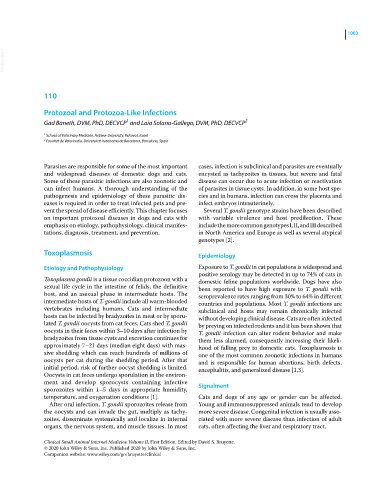Page 1065 - Clinical Small Animal Internal Medicine
P. 1065
1003
VetBooks.ir
110
Protozoal and Protozoa‐Like Infections
1
Gad Baneth, DVM, PhD, DECVCP and Laia Solano‐Gallego, DVM, PhD, DECVCP 2
1 School of Veterinary Medicine, Hebrew University, Rehovot, Israel
2 Facultat de Veterinaria, Universitat Autonoma de Barcelona, Barcelona, Spain
Parasites are responsible for some of the most important cases, infection is subclinical and parasites are eventually
and widespread diseases of domestic dogs and cats. encysted as tachyzoites in tissues, but severe and fatal
Some of these parasitic infections are also zoonotic and disease can occur due to acute infection or reactivation
can infect humans. A thorough understanding of the of parasites in tissue cysts. In addition, in some host spe-
pathogenesis and epidemiology of these parasitic dis- cies and in humans, infection can cross the placenta and
eases is required in order to treat infected pets and pre- infect embryos intrauterinely.
vent the spread of disease efficiently. This chapter focuses Several T. gondii genotype strains have been described
on important protozoal diseases in dogs and cats with with variable virulence and host predilection. These
emphasis on etiology, pathophysiology, clinical manifes- include the more common genotypes I, II, and III described
tations, diagnosis, treatment, and prevention. in North America and Europe as well as several atypical
genotypes [2].
Toxoplasmosis Epidemiology
Etiology and Pathophysiology Exposure to T. gondii in cat populations is widespread and
positive serology may be detected in up to 74% of cats in
Toxoplasma gondii is a tissue coccidian protozoon with a domestic feline populations worldwide. Dogs have also
sexual life cycle in the intestine of felids, the definitive been reported to have high exposure to T. gondii with
host, and an asexual phase in intermediate hosts. The seroprevalence rates ranging from 30% to 64% in different
intermediate hosts of T. gondii include all warm‐blooded countries and populations. Most T. gondii infections are
vertebrates including humans. Cats and intermediate subclinical and hosts may remain chronically infected
hosts can be infected by bradyzoites in meat or by sporu- without developing clinical disease. Cats are often infected
lated T. gondii oocysts from cat feces. Cats shed T. gondii by preying on infected rodents and it has been shown that
oocysts in their feces within 3–10 days after infection by T. gondii infection can alter rodent behavior and make
bradyzoites from tissue cysts and excretion continues for them less alarmed, consequently increasing their likeli-
approximately 7–21 days (median eight days) with mas- hood of falling prey to domestic cats. Toxoplasmosis is
sive shedding which can reach hundreds of millions of one of the most common zoonotic infections in humans
oocysts per cat during the shedding period. After that and is responsible for human abortions, birth defects,
initial period, risk of further oocyst shedding is limited. encephalitis, and generalized disease [1,3].
Oocysts in cat feces undergo sporulation in the environ-
ment and develop sporocysts containing infective Signalment
sporozoites within 1–5 days in appropriate humidity,
temperature, and oxygenation conditions [1]. Cats and dogs of any age or gender can be affected.
After oral infection, T. gondii sporozoites release from Young and immunosuppressed animals tend to develop
the oocysts and can invade the gut, multiply as tachy- more severe disease. Congenital infection is usually asso-
zoites, disseminate systemically and localize in internal ciated with more severe disease than infection of adult
organs, the nervous system, and muscle tissues. In most cats, often affecting the liver and respiratory tract.
Clinical Small Animal Internal Medicine Volume II, First Edition. Edited by David S. Bruyette.
© 2020 John Wiley & Sons, Inc. Published 2020 by John Wiley & Sons, Inc.
Companion website: www.wiley.com/go/bruyette/clinical

